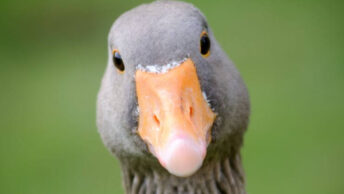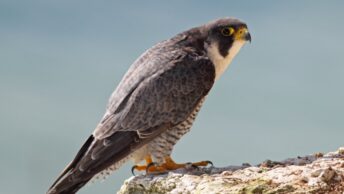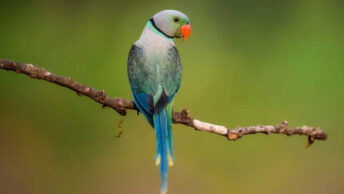Avian longevity varies dramatically, from just a few years to nearly a century, shaped by factors such as size, lifestyle, and environment. The kakapo is the world’s longest-living bird, with individuals reaching an age of 90-100 under favorable conditions. However, the record for the longest-lived wild bird goes to Wisdom, a Laysan albatross banded in 1956 and still breeding in 2025 at over 74 years old.
This article explores the longest-living birds using verified longevity records from both wild and captive individuals. We focus on species with exceptional lifespans, strong documentation, and particular significance, highlighting the life-history traits that enable such endurance – from slow maturation and low reproductive output to high adult survival.
Kakapo
Strigops habroptilus
- Maximum age: Up to 100 years.
- Typical lifespan: Around 60 years.
- Where found: Predator-free offshore islands of New Zealand.
- Conservation status: Critically Endangered.
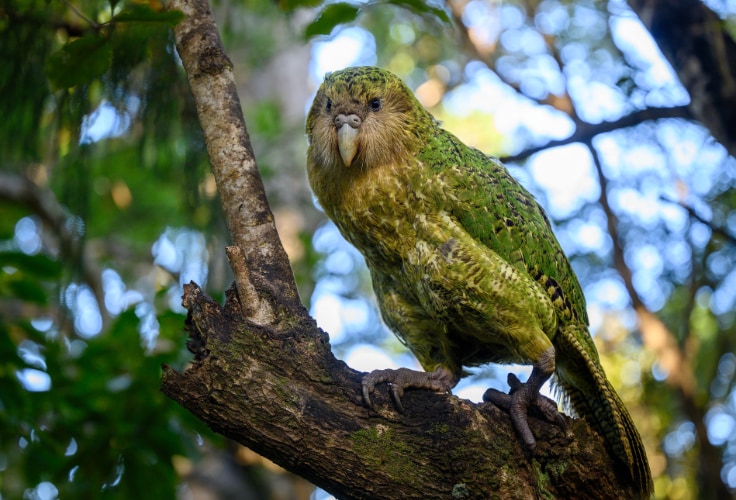
The kakapo is the longest-living bird species known, with some individuals believed to approach or even exceed 100 years. The most notable case is Richard Henry, a male captured as an adult in Fiordland in 1975 and named after the pioneering New Zealand conservationist of the same name. As the last known bird from the South Island population, he became a symbol of the species’ survival.
Richard Henry died in 2010, and while his exact age was unknown, most sources estimate he was around 80 years old at the time of death. More broadly, the kakapo’s average life expectancy is estimated at around 60 years.
Such longevity is rare among birds, particularly parrots, and is matched by a very slow life history: males begin vocal mating displays around age 5, and females may not breed until they are at least 5 to 9 years old. Breeding occurs only sporadically, typically every two to five years, synchronized with mast fruiting events of native trees like rimu.
The kakapo is the world’s only flightless parrot, as well as the heaviest and one of the most unique in both appearance and behavior. Once widespread across New Zealand, it was nearly driven to extinction due to introduced mammalian predators and habitat destruction. By the 1990s, the global population had fallen below 50. Today, over 250 individuals remain, all under intensive conservation management on predator-free islands such as Whenua Hou and Anchor.
Despite high adult survival, the kakapo’s recovery is limited by infertility and inbreeding. Conservationists use artificial insemination, genome sequencing, and AI-assisted nest monitoring to boost success. As one of the rarest parrots in the world, the kakapo stands as both an evolutionary oddity and a global symbol of high-tech conservation.
Scarlet Macaw
Ara macao
- Maximum age: Up to 90 years.
- Typical lifespan: 40-50 years.
- Where found: Tropical lowland forests of Central and South America.
- Conservation status: Least Concern.
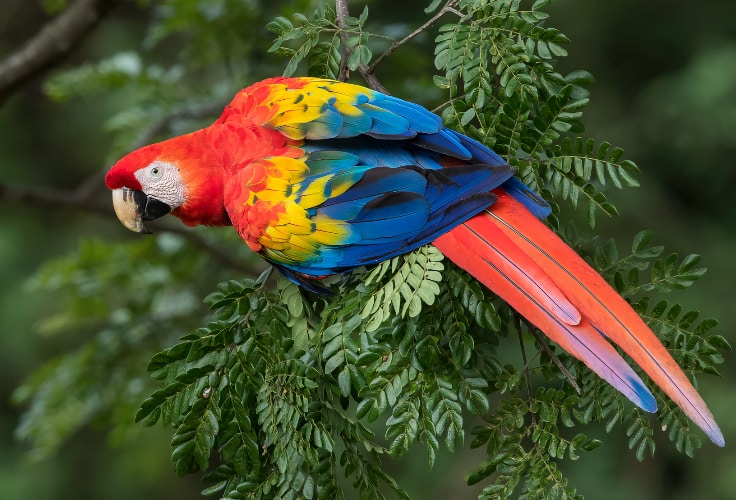
The scarlet macaw is not only one of the most strikingly colorful birds in the Americas, but also one of the longest-lived. In captivity, individuals have reportedly reached 75 years or more, with occasional claims nearing 90. More typically, they live 40 to 50 years, especially when provided with proper diet, space, and veterinary care.
Wild lifespan is harder to quantify due to fewer long-term studies, but macaws’ slow reproductive rate and late maturity (usually around 5 years of age) suggest an inherently long-lived life history strategy.
Scarlet macaws are native to tropical forests and woodlands from southern Mexico through the Amazon basin. Although still locally abundant, they have disappeared from many parts of their former range due to deforestation and illegal trapping for the pet trade. These birds are highly intelligent and social, often forming lifelong pair bonds and traveling in vocal flocks through the canopy.
Their long lifespan, vivid plumage, and strong pair fidelity have made them cultural icons, but also targets for exploitation. Conservation efforts now focus on habitat preservation and curbing the illegal trade that threatens their survival in the wild.
Pink Cockatoo
Cacatua leadbeateri
- Maximum age: 83 years.
- Typical lifespan: 50-60 years.
- Where found: Semi-arid woodlands of inland and southern Australia.
- Conservation status: Least Concern.

The pink cockatoo, also known as Major Mitchell’s cockatoo, is among the longest-living parrots ever recorded. While typical individuals live around five to six decades, a remarkable male named Cookie reached the age of 83 while residing at Brookfield Zoo in Illinois, USA. Hatched in 1933 and arriving from Sydney’s Taronga Zoo the following year, Cookie became a local celebrity and was recognized by Guinness World Records as the oldest living parrot before his death in 2016.
His long life was not without challenges, he suffered age-related conditions such as arthritis and osteoporosis, but attentive care, dietary adjustments, and retirement from public display helped him thrive into extreme old age.
In the wild, pink cockatoos inhabit the drier woodlands of Australia, favoring areas with large eucalypts or native pine trees for nesting. While widespread, their numbers have declined in parts of their southern range due to habitat clearance, livestock grazing, invasive weeds, and nest poaching. Some populations have vanished from regions like the Adelaide Plains. However, others, particularly in arid western zones, remain more stable.
The species is known for its striking coloration and social intelligence, but also its selectiveness in pair bonding – as shown by Cookie himself, who rejected a proposed mate in the 1950s for not being “nice” to him.
Andean Condor
Vultur gryphus
- Maximum age: 79 years.
- Typical lifespan: Over 50 years.
- Where found: Andes Mountains and adjacent lowlands from Colombia to southern Chile and Argentina.
- Conservation status: Vulnerable.
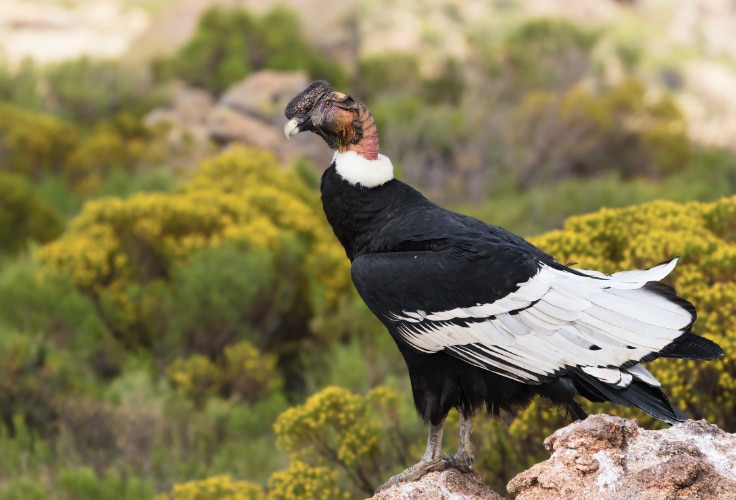
The Andean condor is an exceptionally long-lived vulture, with captive individuals documented at extraordinary ages. The oldest confirmed case is Thaao, a male born in 1930 and cared for at Beardsley Zoo until his death in 2010 at the age of 79. Other captive condors have surpassed 70 years, and while wild data is scarce, birds are believed to routinely live beyond 50 years under natural conditions.
As one of the largest flying birds in the world, boasting a wingspan of up to 3.3 meters (10.8 feet), the condor’s slow-paced life strategy is closely tied to its status as a scavenger and apex aerial presence. This iconic vulture of the Andes soars across high-altitude grasslands, mountains, and coastal deserts, using thermal currents to travel vast distances in search of carrion.
Reaching sexual maturity only around 6 to 8 years of age, condors breed slowly, raising a single chick every other year. Their longevity offers a buffer against low reproductive rates, but population declines are now driven by human threats, particularly poisoning, persecution, and widespread lead exposure from bullet-ridden carcasses.
Despite their size and power, Andean condors are vulnerable, making every long-lived individual critical to the survival of the species.
Laysan Albatross
Phoebastria immutabilis
- Maximum age: At least 74 years.
- Typical lifespan: 40-50 years.
- Where found: North Pacific Ocean, breeding on remote islands such as Midway Atoll and other Northwestern Hawaiian Islands.
- Conservation status: Near Threatened.
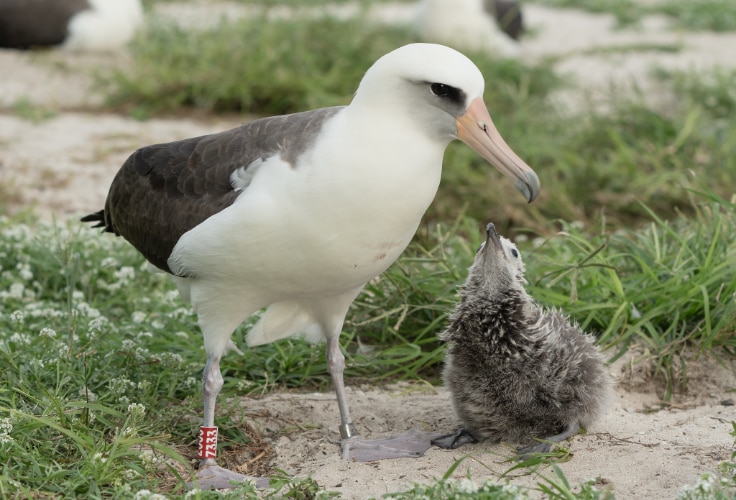
The Laysan albatross is renowned for its impressive lifespan, with a remarkable case that continues to expand our understanding of seabird longevity. A wild female known as Wisdom, banded in 1956, was already an adult at the time and is now estimated to be over 74 years old – still healthy, active, and seen at her breeding colony as recently as early 2025. Over her lifetime, she has likely laid 50-60 eggs, fledged some 30 chicks, and flown more than 3 million miles over the Pacific.
Most Laysan albatrosses live for 40 to 50 years, but Wisdom’s case demonstrates the extreme upper limit of the species’ lifespan and the resilience of long-lived seabirds.
Laysan albatrosses breed on isolated islands, particularly within the Hawaiian archipelago, where they gather in large, dense colonies. They are monogamous and invest heavily in raising a single chick per season – if they breed at all that year. The breeding cycle is extended, involving months of incubation, brooding, and chick feeding with rich stomach oil regurgitated at sea.
Despite decades of recovery since feather exploitation in the early 20th century, the species remains threatened due to habitat loss, ocean plastic ingestion, and fisheries bycatch, though stable or increasing on some protected islands.
Eurasian Eagle-Owl
Bubo bubo
- Maximum age: 68 years.
- Typical lifespan: 15-20 years.
- Where found: Rocky forests, cliffs, and open woodlands across Europe and Asia
- Conservation status: Least Concern.
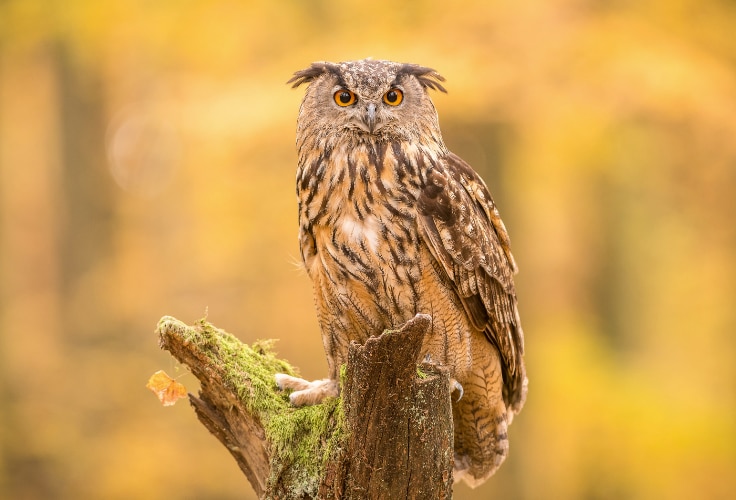
The Eurasian eagle-owl is not only one of the largest owls in the world but also among the longest-lived. In the wild, lifespans commonly reach 15 to 20 years, with a ringed individual once recorded at nearly 28 years of age. In captivity, where threats like disease, food scarcity, and human interference are minimized, some individuals have reportedly lived as long as 68 years.
Healthy adults rarely fall prey to other animals and are considered apex predators throughout their vast range. The Eurasian eagle-owl hunts a wide array of prey, from rodents and rabbits to large birds and even other owls, and plays a key role in maintaining ecological balance.
This species inhabits rugged landscapes from western Europe to Central Asia, favoring cliffs, ravines, and forested valleys for nesting. It is monogamous and often reuses the same nest sites for multiple years.
Despite a widespread and stable population, the species still suffers fatalities from electrocution, traffic collisions, and illegal shooting, particularly in more developed parts of its range. Its exceptional longevity and commanding presence make it a flagship species for owl conservation.
Common Ostrich
Struthio camelus
- Maximum age: Over 62 years.
- Typical lifespan: 30-40 years.
- Where found: Open savannas, arid plains, and semi-deserts across sub-Saharan Africa.
- Conservation status: Least Concern.
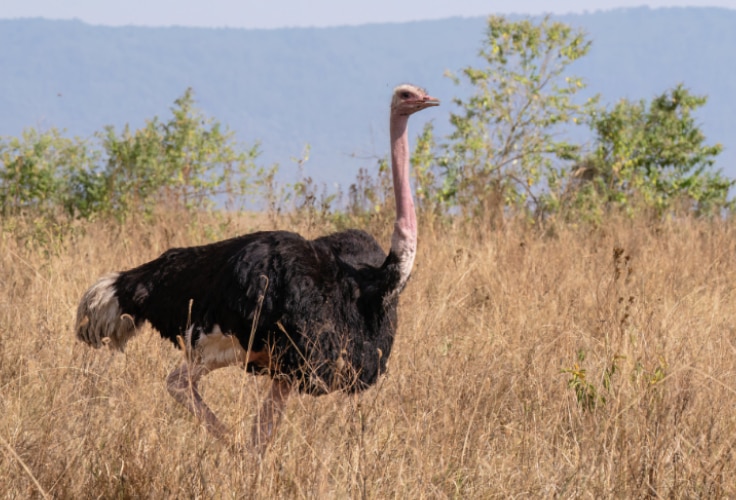
The common ostrich is the largest living bird and one of the longest-lived, with individuals in the wild typically reaching 30 to 40 years of age. Under human care, this remarkable species can live even longer; the oldest known captive ostrich survived to 62 years and 7 months.
Like many long-lived birds, ostriches face high mortality in early life – fewer than 10% of nests survive the full laying and incubation period, and only about 15% of chicks reach their first year. Those that do survive into adulthood, however, benefit from a body built for endurance and defense, including powerful legs and robust cardiovascular capacity.
Mature ostriches exhibit a polygynous mating system and reach sexual maturity between 2 and 4 years of age, with females generally maturing earlier than males. Though typically shy, adults are formidable when threatened: the ostrich is capable of running at sustained speeds of over 70 km/h (43 mph) and short bursts approaching 97 km/h (60 mph), making it the fastest bird on land. Its kicks can be deadly to both predators and, in rare cases, humans.
This blend of speed, strength, and longevity reflects an evolutionary strategy finely tuned to life in the open and often unforgiving landscapes of Africa.
California Condor
Gymnogyps californianus
- Maximum age: Over 60 years.
- Typical lifespan: 50-60 years.
- Where found: Mountainous and canyon regions of western North America, including California, Arizona, Utah, and Baja California.
- Conservation status: Critically Endangered.
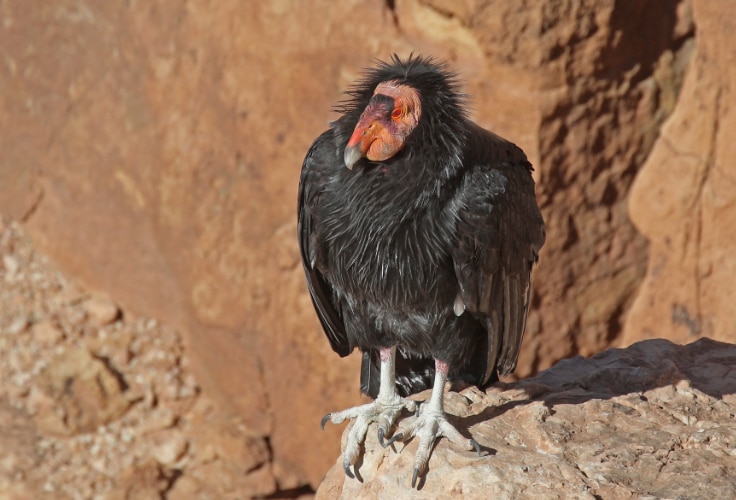
The California condor is one of the rarest birds in the world, and its inclusion here highlights a striking contrast between extreme longevity and near-extinction.
Capable of reaching 60 years or more under favorable conditions, this species depends heavily on its long lifespan to offset an exceptionally slow reproductive rate. Condors reach maturity only at 6 to 7 years of age and typically raise just one chick every other year, making the survival of each adult vital to population stability.
In captivity, where threats like lead poisoning and food scarcity are eliminated, some individuals have been reported to live well beyond 60, though many condors in breeding programs have yet to reach their natural lifespan limits. In the wild, however, mortality remains high due to human-caused hazards.
Declared extinct in the wild by 1987, the California condor has since made a fragile comeback through one of the most intensive recovery efforts in avian history. As of 2025, the global population has risen to 566 birds, with 369 flying free across parts of the western United States and Baja California.
Yet the species remains dependent on constant human support. Lead poisoning from ammunition is still the leading cause of death, alongside collisions with power lines and ingestion of micro-trash. In this context, the condor’s longevity is not just an evolutionary trait – it’s a critical buffer against extinction.
Gray Parrot
Psittacus erithacus
- Maximum age: Over 60 years.
- Typical lifespan: 20-25 years.
- Where found: Forests and savannas of West and Central Africa.
- Conservation status: Endangered.
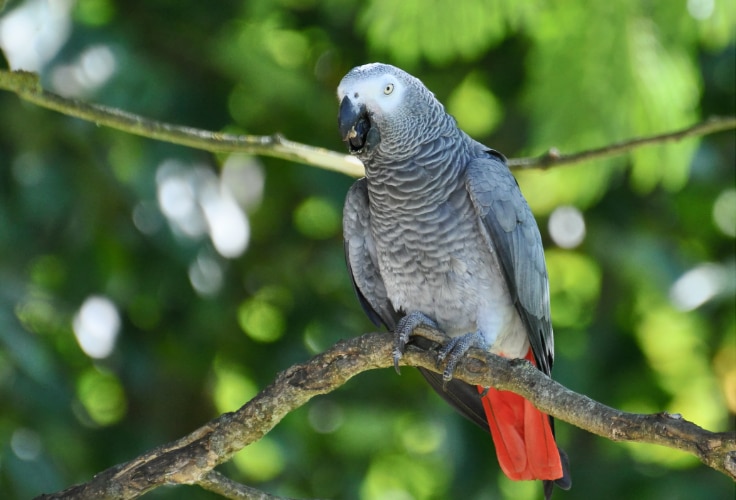
The gray parrot is one of the most intelligent birds on the planet and also among the longest-living parrot species. In captivity, individuals commonly reach 40 to 60 years of age with proper care, while wild birds tend to live shorter lives, averaging 20 to 25 years.
Gray parrots typically reach sexual maturity between three and five years old and breed in tree cavities, often forming loose colonies in parts of their range. Their long lifespan, both in the wild and under human care, is closely tied to their slow maturation and low annual reproductive output.
Highly social and remarkably intelligent, gray parrots have been observed using complex vocalizations to communicate within flocks and solve problems while foraging. The most famous individual, Alex, demonstrated extraordinary cognitive abilities in a 30-year study, including object recognition, numerical understanding, and the use of simple language.
In the wild, however, these abilities have not protected them from severe population decline. Intensive trapping for the pet trade and habitat destruction have led to widespread reductions across their range. Although they are still locally common in parts of Central Africa, the species’ future depends heavily on habitat preservation and the strict control of illegal trade.
Emperor Penguin
Aptenodytes forsteri
- Maximum age: Up to 50 years.
- Typical lifespan: Around 20 years.
- Where found: Coastal regions of Antarctica.
- Conservation status: Near Threatened.
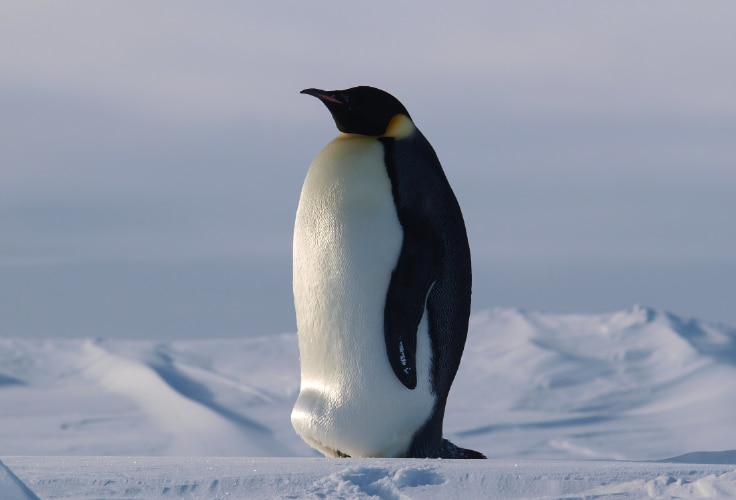
The emperor penguin, the largest of all penguin species, is exceptionally well adapted to the harsh Antarctic environment. In the wild, adult individuals typically live for about 20 years, with a high annual survival rate of over 95%. However, rare individuals are believed to reach up to 50 years of age, according to long-term survival modeling studies.
Despite this potential for longevity, most emperor penguins never reach adulthood – only around 19% of chicks survive their first year, resulting in a life cycle dominated by older individuals that have successfully navigated the challenges of juvenile survival.
Emperor penguins breed exclusively in Antarctica, forming colonies on stable land-fast sea ice during the brutal austral winter. After laying a single egg in May or June, the female returns to sea to feed while the male incubates the egg for about two months without eating.
These birds rely heavily on seasonal ice for breeding and foraging, making them highly vulnerable to climate change. Projected sea ice loss could eliminate over 80% of their population by the end of the century if emissions remain unchecked. Yet, their extraordinary physiology and remarkable lifespan have made them enduring symbols of adaptation and survival in one of the planet’s most extreme environments.
Bald Eagle
Haliaeetus leucocephalus
- Maximum age: Up to 50 years.
- Typical lifespan: 15-20 years.
- Where found: Across North America, especially near large lakes and rivers.
- Conservation status: Least Concern.
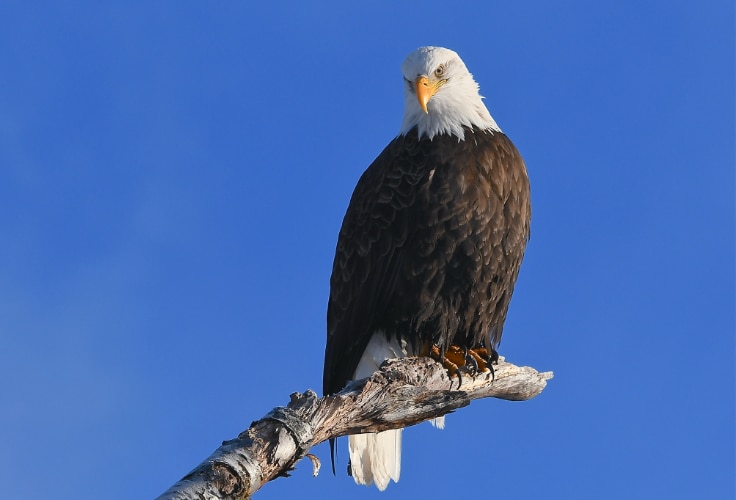
The bald eagle, a symbol of strength and freedom, is also among the longest-living raptors in the wild. While the average lifespan of wild individuals is around 15 to 20 years, the oldest known bald eagle reached 38 before its death in New York in 2015, setting a national longevity record. That eagle, banded as a nestling in Minnesota in 1977 and relocated to the Montezuma National Wildlife Refuge, was a key figure in New York’s pioneering Bald Eagle Restoration Program.
In captivity, where threats like trauma and poisoning are minimized, bald eagles have been known to approach 50 years of age.
Known for their massive wingspan and piercing gaze, bald eagles are among the world’s largest eagles and are monogamous, typically forming lifelong pair bonds. They build enormous stick nests in tall trees or cliffs, often returning to the same site year after year.
Their dramatic comeback in the United States, following near-extinction due to DDT exposure and persecution, is one of the most celebrated conservation success stories. Now widespread and increasing in number, these birds continue to benefit from habitat protections and remain powerful emblems of avian resilience and longevity.
Great Frigatebird
Fregata minor
- Maximum age: At least 44 years.
- Typical lifespan: 30-35 years.
- Where found: Tropical oceans and islands across the Pacific, Indian, and South Atlantic.
- Conservation status: Least Concern.
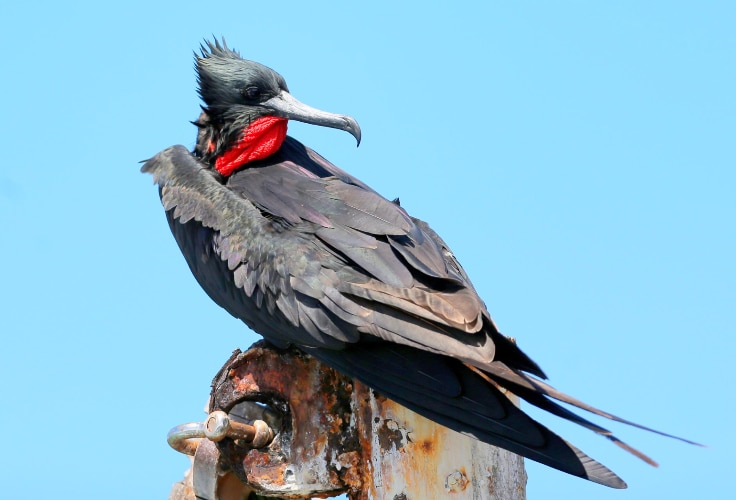
The great frigatebird is a long-lived seabird of tropical oceans, with verified lifespans exceeding four decades. A study on Tern Island in Hawaii found that 10 out of 35 banded individuals were 37 years or older, and one had survived for at least 44 years.
Such longevity is accompanied by an exceptionally slow life history: females do not begin breeding until at least 8-9 years of age, and males often not until 10 or 11 – remarkably late even among long-lived species.
Great frigatebirds nest in remote colonies on small tropical islands, usually building simple stick nests in low vegetation. They are best known for their aerial prowess and dramatic courtship displays, during which males inflate bright red throat pouches to attract females.
Though they sometimes engage in kleptoparasitism (harassing other birds to steal food), this behavior is rare compared to their more typical foraging at sea. Their ability to soar effortlessly for days, combined with slow reproduction and a long development period, reflects an evolutionary strategy favoring endurance and longevity in the open ocean.
Common Raven
Corvus corax
- Maximum age: Over 40 years.
- Typical lifespan: 10-15 years.
- Where found: Forests, mountains, tundra, and open landscapes across the Northern Hemisphere.
- Conservation status: Least Concern.
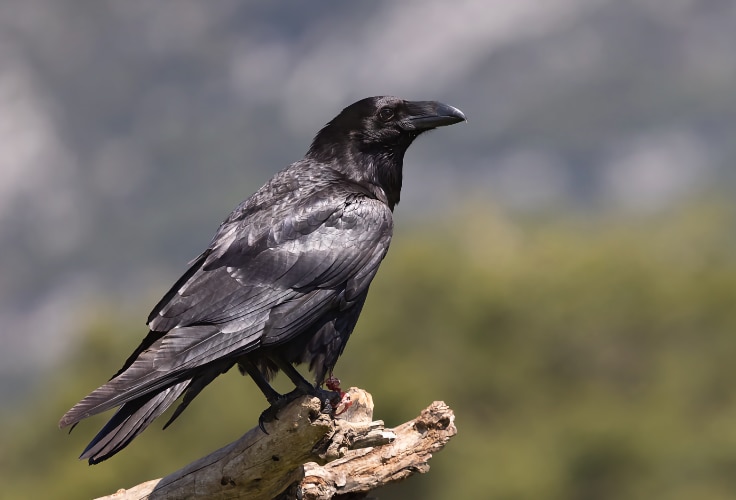
The common raven is one of the longest-living songbirds, especially in captivity or protected environments. While wild individuals generally live between 10 and 15 years, the longest recorded lifespan for a banded wild raven is 23 years and 3 months.
In managed care, ravens have far exceeded this: multiple individuals have lived beyond 40 years, particularly those kept at the Tower of London, where their longevity has become part of tradition and legend. Anecdotal reports even claim ravens living to 69 or 80 years, though such figures remain unverified.
Renowned for their intelligence and adaptability, common ravens occupy a vast range of habitats from Arctic tundra to desert canyons and temperate rainforests. Their nests are large stick platforms, often built on cliffs, trees, or human structures. Pairs are typically monogamous and may reuse the same nesting sites for many years.
Ravens feed on an extraordinarily wide diet, from carrion and garbage to small animals and plant matter. Their behavioral complexity, long developmental period, and close long-term pair bonds contribute to their extended lifespan, especially in environments where threats are minimized and food sources are reliable.
Common Tern
Sterna hirundo
- Maximum age: 33 years.
- Typical lifespan: 10-12 years.
- Where found: Breeds across Europe, Asia, and North America; winters along coasts of South America, Africa, and southern Asia.
- Conservation status: Least Concern.

The common tern is a remarkably agile seabird with a broad distribution and a capacity for longevity rarely appreciated in such a small, migratory species. While most individuals live around a decade, exceptional wild terns have been recorded at ages of 28 in North America and up to 33 in Europe.
These records reflect both the durability and resilience of individuals that survive the challenges of long-distance migration, coastal storms, and shifting food availability.
Terns generally begin breeding at 3 to 4 years of age, and their reproductive success tends to increase with experience, especially over the first five years of adulthood. This species breeds in colonies along coasts, islands, and inland water bodies, often returning to the same sites year after year. It is highly migratory, with Palearctic populations wintering as far south as the Falkland Islands and Southeast Asia.
Common terns forage mainly on small fish, diving from flight or hovering low over the water, and may travel more than 10 kilometers (6.2 miles) from the colony to feed. Their long lifespan, though rare on an individual level, contributes to colony stability, particularly in years when weather or food conditions result in widespread breeding failure.
Exceptional But Unverified Cases
While most of the entries in this article are based on banding records, confirmed zoological documentation, or long-term captive care data, a few birds are widely reported to have lived extraordinary lives without formal verification. These cases, though not accepted as scientific records, are worth noting for their plausibility or cultural significance.
Fred the sulphur-crested cockatoo (Cacatua galerita) was a well-known resident of two Australian wildlife sanctuaries: Bonorong and later Byron Bay. At the time of his passing in early 2025, Fred was believed to be 110 years old. Though no official hatch records were made public, both institutions consistently reported his age, and Fred’s story gained widespread recognition.
Having lived through a period of poor care before being rehabilitated, Fred’s later years were marked by attentive management and public affection. His claimed age, while not scientifically validated, makes him a symbol of avian resilience and the potential for extreme longevity among parrots.
In contrast, the story of Charlie the blue-and-yellow macaw (Ara ararauna) is more controversial. Charlie was claimed by her current owner to have once belonged to Winston Churchill and to be over 120 years old, living in a garden center in Surrey, England. However, Churchill’s family and estate have publicly denied the story, and no documentation has ever surfaced to verify Charlie’s age or ownership history. While Charlie may indeed be an older individual, the lack of credible records has rendered her story more folklore than fact.
These examples highlight the challenges in documenting bird longevity over many decades, particularly in species traded as pets or passed between institutions. Though they may not meet scientific standards for confirmed lifespan records, birds like Fred serve as powerful reminders of the importance of proper long-term care, and the remarkable lifespans that some species can achieve under the right conditions.

